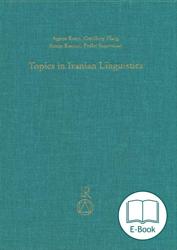The 13 chapters of this volume represent a selection of the papers presented at the “Third International Conference on Iranian Linguistics”, held in September 2009 at the Université Sorbonne Nouvelle in Paris. This series of conferences brings together scholars from all theoretical persuasions has established a tradition of interdisciplinary linguistic research on Iranian languages. This volume represent the dynamic and rapidly growing nature of Iranian linguistics, a field which has united linguists of all persuasions who share a strong commitment to the scientific investigation of Iranian languages, their structure, history and use.
Up until quite recently, research on Iranian languages tended to be conducted in rather distinct disciplines, often with little interaction among them. A major turning point in bringing scholars from all theoretical persuasions together was the “First International Conference on Iranian Linguistics”, held in June 2005 at the Max Planck Institute for Evolutionary Anthropology in Leipzig. It inaugurated a tradition of interdisciplinary linguistic research on Iranian languages that we are proud to continue with the present volume.
The 13 chapters of this volume represent a selection of the papers presented at the “Third International Conference on Iranian Linguistics”, held in September 2009 at the Université Sorbonne Nouvelle in Paris. Part one, historical and comparative Iranian syntax, contains chapters by Saloumeh Gholami, Nicholas Sims-Williams, Antje Wendtland, Agnes Korn, and Arseniy Vydrin. The first three contributions treat the morpho-syntax of two extinct East Iranian languages, revealing a fruitful and innovative synthesis of philological investigations with insights from syntactic typology. Korn’s chapter covers both synchronic and diachronic aspects of a typologically unusual development in a broad range of Iranian languages, while Vydrin’s chapter surveys the expression of counterfactuality within Iranian from a largely synchronic perspective, but informed with areal-typological explanations. Part two, the morpho-syntax of lesser-know Iranian languages, contains contributions by Daniel Paul, Gregory Stump and Andrew Hippisley, and two joint contributions, Oleg Belaev and Arseniy Vydrin, and David Erschler and Vitaly Volk. They reflect a growing interest in the “smaller” Iranian languages, not only as a source for comparative and historical Iranian philology, but also for the insights they offer for general linguistic theory. Part three, the linguistics of Modern Persian, presents new insights on aspects of Modern Persian. Naderi and Oostendorp’s contribution presents an OT-based re-assessment of epenthetic consonants, while Ganjavi revisits the issue of marking vs. non-marking of direct objects. Pirooz looks at control in finite subordinate clauses, while Deravi and Dommergues present the results of an empirical investigation of code-switching by highly proficient Persian-French bilinguals.
Taken together, these contributions represent the dynamic and rapidly growing nature of Iranian linguistics, a field which has united linguists of all persuasions who share a strong commitment to the scientific investigation of Iranian languages, their structure, history and use.
„The volume does, however, represent a most valuable contribution to Iranian linguistics. The range of Iranian languages studied is impressive and most of the articles demonstrate high scholarly competence. The careful editorial work has produced an attractive and cohesive volume. Maps, diagrams, and tables make it easy to get an overview of the articles, which for the most part are innovative and treat a great variety of interesting topics. In addition to answering the research questions posed in the studies, in many cases they invite further research. One veinteresting topic for further studies is presented by Sims-Williams, namely the ditransitive construction and the encoding of addressees, recipients, and benefactives. Other topics treated in this volume that would be interesting to study in a variety of Iranian languages include the development of perfect forms, deixis, consonant epenthesis, and finite control.“
Von Carina Jahani, Department of Linguistics and Philology, Uppsala University
In: Orientalia Suecana VOL. LXI (2012) S. 214- 217.
Agnes Korn
Studium der Indogermanistik, Indologie und Iranistik in Hamburg und Wien (Mag.a phil. 1996), Promotionsstudium der Vergleichenden Sprachwissenschaft in Frankfurt a. M. (Dr. phil. 2003), Habilitation in Vergleichender Sprachwissenschaft in Frankfurt a. M. (PD 2010);
Lektorin für Deutsch in Banská Bystrica/Slowakei (1995-96), Mitarbeit bei der Österreichischen Akademie der Wissenschaften / Kommission für Iranistik in Wien (1996-97) und an einem Wörterbuchprojekt an der Universität Graz (1996-98), seit 1998 am Institut für Vergleichende Sprachwissenschaft, Phonetik und Slavische Philologie der Johann-Wolfgang-Goethe-Universität Frankfurt a. M.
Forschungsschwerpunkt: Historische Grammatik der iranischen Sprachen
The series Beiträge zur Iranistik was founded in the 1960s by Georges Redard and subsequently edited by Nicholas Sims-Williams from 1997 to 2020; the present series editor is Agnes Korn.
The series publishes works on the languages of the Iranian branch of Indo-European. The focus is on linguistics, including grammars, dictionaries, text editions, philology as well as diachronic and synchronic studies of linguistic topics. Neighbouring fields such as literature, archaeology and anthropology are likewise represented. The languages of the series are English, German and French. The Beiträge zur Iranistik are represented in libraries internationally and are widely used standard works of Iranian studies.


 Vorwort
Vorwort